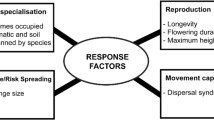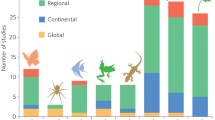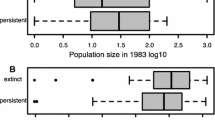Abstract
Few assessments of species vulnerability to climate change used to inform conservation management consider the intrinsic traits that shape species’ capacity to respond to climate change. This omission is problematic as it may result in management actions that are not optimised for the long-term persistence of species as climates shift. We present a tool for explicitly linking data on plant species’ life history traits and range characteristics to appropriate management actions that maximise their capacity to respond to climate change. We deliberately target data on easily measured and widely available traits (e.g. dispersal syndrome, height, longevity) and range characteristics (e.g. range size, climatic/soil niche breadth), to allow for rapid comparison across many species. We test this framework on 1237 plants, categorising species on the basis of their potential climate change risk as related to four factors affecting their response capacity: reproduction, movement capability, abiotic niche specialisation and spatial coverage. Based on these four factors, species were allocated risk scores, and these were used to test the hypothesis that the current protection status under national legislation and related management actions capture species response capacity to climate change. Our results indicate that 20% of the plant species analysed (242 species) are likely to have a low capacity to respond to climate change based on the traits assessed, and are therefore at high risk. Of the 242 high risk species, only 10% (24 species) are currently listed for protection under conservation legislation. Importantly, many management plans for these listed species fail to address the capacity of species to respond to climate change with appropriate actions: 70% of approved management plans do not include crucial actions which may improve species’ ability to adapt to climate change. We illustrate how the use of easily attainable traits associated with ecological and evolutionary responses to changing environmental conditions can inform conservation actions for plant species globally.



Similar content being viewed by others
References
Ackerly DD (2003) Community assembly, niche conservatism, and adaptive evolution in changing environments. Int J Plant Sci 164:165–184
Angert AL, Crozier LG, Rissler LJ et al (2011) Do species’ traits predict recent shifts at expanding range edges? Ecol Lett 14:677–689
Araújo MB, Ferri-Yáñez F, Bozinovic F et al (2013) Heat freezes niche evolution. Ecol Lett 16:1206–1219
Beadle NCW (1966) Soil phosphate and its role in molding segments of the Australian flora and vegetation, with special reference to xeromorphy and sclerophylly. Ecology 47:992–1007
Beever EA, O'Leary J, Mengelt C et al (2016) Improving conservation outcomes with a new paradigm for understanding species’ fundamental and realized adaptive capacity. Conserv Lett 9:131–137
Bellard C, Bertelsmeier C, Leadley P et al (2012) Impacts of climate change on the future of biodiversity. Ecol Lett 15:365–377
Burgman MA, Fox JC (2003) Bias in species range estimates from minimum convex polygons: implications for conservation and options for improved planning. In Anim Conserv forum (Vol. 6, No. 1, pp. 19–28). Cambridge University Press
Butchart SHM, Walpole M, Collen B et al (2010) Global biodiversity: indicators of recent declines. Science 328:1164–1168
Bush A, Mokany K, Catullo R et al (2016) Incorporating evolutionary adaptation in species distribution modelling reduces projected vulnerability to climate change. Ecol Lett 19:1468–1478
Butt N, Pollock L, McAlpine C (2013) Eucalypts face increasing climate stress. Ecology and Evolution 3:5011–5022. https://doi.org/10.1002/ece3.873
Butt N, Possingham HP, De Los Rios C et al (2016) Challenges in assessing the vulnerability of species to climate change to inform conservation actions. Biol Conserv 199:10–15
Cabrelli AL, Stow AJ, Hughes L (2014) A framework for assessing the vulnerability of species to climate change: a case study of the Australian elapid snakes. Biodivers Conserv 23:3019
Cai WJ, Cowan T, Thatcher M (2012) Rainfall reductions over southern hemisphere semi-arid regions: the role of subtropical dry zone expansion. Sci Rep 2:702. https://doi.org/10.1038/srep00702
Cayuela L, Granzow-de la Cerda I, Albuquerque FS, Golicher DJ (2012) Taxonstand: an R package for species names standardisation in vegetation databases. Methods Ecol Evol 3:1078–1083
Chen IC, Hill JK, Ohlemüller R (2011) Rapid range shifts of species associated with high levels of climate warming. Science 333:1024–1026
Chessman BC (2013) Identifying species at risk from climate change: Traits predict the vulnerability of freshwater fishes. Biol Conserv 160:40–49
Christmas MJ, Breed MF, Lowe AJ (2016) Constraints to and conservation implications for climate change adaptation in plants. Conserv Genet 17:305
Dawson TP, Jackson SY, House JI et al (2011) Beyond predictions: biodiversity conservation in a changing climate. Science 332:53–58
Damschen EI, Harrison S, Ackerly DD et al (2012) Endemic plant communities on special soils: early victims or hardy survivors of climate change? J Ecol 100:1122–1130
Eriksson O, Friis EM, Löfgren P (2000) Seed size, fruit size, and dispersal systems in angiosperms from the early cretaceous to the late tertiary. Am Nat 156:47–58
Foden WB, Butchart SHM, Stuart SN et al (2013) Identifying the world’s most climate change vulnerable species: a systematic trait-based assessment of all birds, amphibians and corals. PLoS One 8(6):e65427. https://doi.org/10.1371/journal.pone.0065427
Fordham DA, Resit Akçakaya H, Araújo MB et al (2012) Plant extinction risk under climate change: are forecast range shifts alone a good indicator of species vulnerability to global warming? Glob Chang Biol 18:1357–1371. https://doi.org/10.1111/j.1365-2486.2011.02614.x
Fortuni L, Schubert O (2017) Beyond exposure, sensitivity and adaptive capacity: a response based ecological framework to assess species climate change vulnerability. Climate Change Responses 4:2. https://doi.org/10.1186/s40665-017-0030-y
Fowler HJ, Wilby RL (2007) Beyond the downscaling comparison study. Int J Climatol 27:1543–1545. https://doi.org/10.1002/joc.1616
Franks SJ, Weber JJ, Aitken SN (2014) Evolutionary and plastic responses to climate change in terrestrial plant populations. Evol Appl 7:123–139
Gallagher RV (2016) Correlates of range size variation in the Australian seed-plant flora. J Biogeogr 43:1287–1298
Gardali T, Seavy NE, DiGaudio RT, Comrack LA (2012) A climate change vulnerability assessment of California’s at-risk birds. PLoS One 7:e29507
Garcia RA, Araújo MB, Burgess ND et al (2014) Matching species traits to projected threats and opportunities from climate change. J Biogeogr 41:724–735
Gibson MR, Richardson DM, Marchante E et al (2011) Reproductive biology of Australian acacias: important mediator of invasiveness? Divers Distrib 17:911–933
Gillson L, Dawson TP, Jack S, McGeoch MA (2013) Accommodating climate change contingencies in conservation strategy. TREE 28:135–142
Gosper CR, O'Donnell AJ, Yates CJ et al (2016) Better planning outcomes require adequate data and ecological understanding to be successful and credible: a reply to Evans et al. 2015. Biol Conserv 200:240–241
Groves RH (1994) Australian vegetation. Cambridge University Press, Cambridge
Hejda M, Hanzelka J, Kadlec T, Štrobl M, Pyšek P, Reif J (2017) Impacts of an invasive tree across trophic levels: species richness, community composition and resident species’ traits. Divers Distrib 23:997–1007. https://doi.org/10.1111/ddi.12596
Hoekstra JM, Boucher TM, Ricketts TH, Roberts C (2005) Confronting a biome crisis: global disparities of habitat loss and protection. Ecol Lett 8:23–29
Hoffmann AA, Sgrò CM (2011) Climate change and evolutionary adaptation. Nature 470:479–485
Hooper DU, Adair EC, Cardinale BJ et al (2012) A global synthesis reveals biodiversity loss as a major driver of ecosystem change. Nature 486:105–108
Hughes L (2000) Biological consequences of global warming: is the signal already apparent? TREE 15:56–61
IPCC (2013) Climate change 2013: the physical science basis. Contribution of working group I to the fifth assessment report of the intergovernmental panel on climate change (eds Stocker TF, Qin D, Plattner G-K, et al.), IPCC, Cambridge
IUCN Standards and Petitions Subcommittee (2016) Guidelines for using the IUCN red list categories and criteria. Version 12. Prepared by the Standards and Petitions Subcommittee http://www.iucnredlist.org/documents/RedListGuidelines.pdf
Lambers H, Shane MW, Cramer MD et al (2006) Root structure and functioning for efficient acquisition of phosphorus: matching morphological and physiological traits. Ann Bot 98:693–713
Lee JR, Maggini R, Taylor MFJ, Fuller RA (2015) Mapping the drivers of climate change vulnerability for Australia's threatened species. PLoS One 10:e0124766
Leishman MR, Gallagher RV (2015) Will there be a shift to alien-dominated vegetation assemblages under climate change? Divers Distrib 21:848–852
McDonald-Madden E, Baxter PW, Possingham HP (2008) Making robust decisions for conservation with restricted money and knowledge. J Appl Ecol 45:1630–1638
Mace GM, Collar NJ, Gaston KJ et al (2008) Quantification of extinction risk: IUCN's system for classifying threatened species. Conserv Biol 22:1424–1442
Moles AT, Warton DI, Warman L et al (2009) Global patterns in plant height. J Ecol 97:923–932
Moritz C, Agudo R (2013) The future of species under climate change: resilience or decline? Science 341:504–508
Murdoch W, Polasky S, Wilson KA et al (2007) Maximizing return on investment in conservation. Biol Conserv 139:375–388
Nicholls N (2004) The changing nature of Australian droughts. Clim Chang 63:323–336
Nicotra AB, Atkin OK, Bonser SP et al (2010) Plant phenotypic plasticity in a changing climate. Trends Plant Sci 15:684–692
Nicotra AB, Beever EA, Robertson AL et al (2015) Assessing the components of adaptive capacity to improve conservation and management efforts under global change. Conserv Biol 29:1268–1278
Olsen DM, Dinerstein E, Wikramanayake ED et al (2011) Terrestrial ecoregions of the world: a new map of life on earth: a new global map of terrestrial ecoregions provides an innovative tool for conserving biodiversity. BioScience 51:933–938
Pacifici M, Foden WB, Visconti P et al (2015) Assessing species vulnerability to climate change. Nat Clim Chang 5:215–224
Pearson RG, Stanton JC, Shoemaker KT et al (2014) Life history and spatial traits predict extinction risk due to climate change. Nat Clim Chang 4:217–221
Pecl GT, Araújo MB, Bell JD et al (2017) Biodiversity redistribution under climate change: impacts on ecosystems and human well-being. Science 355:eaai9214
Pyšek P, Jarošík V, Hulme PE, Pergl J, Hejda M, Schaffner U, Vilà M (2012) A global assessment of invasive plant impacts on resident species, communities and ecosystems: the interaction of impact measures, invading species' traits and environment. Glob Chang Biol 18:1725–1737. https://doi.org/10.1111/j.1365-2486.2011.02636.x
Segan DB, Hole DG, Donatti CI et al (2015) Considering the impact of climate change on human communities significantly alters the outcome of species and site-based vulnerability assessments. Divers Distrib 21:1101–1111
Seidler TG, Plotkin JB (2006) Seed dispersal and spatial pattern in tropical trees. PLoS Biol 4:e344
Skelly DK, Joseph LN, Possingham HP et al (2007) Evolutionary responses to climate change. Conserv Biol 21:1353–1355
Slatyer RA, Hirst M, Sexton JP (2013) Niche breadth predicts geographical range size: a general ecological pattern. Ecol Lett 16:1104–1114
Smith IN (2004) Trends in Australian rainfall: are they unusual? Aust Meteorol Mag 53:11
Stohlgren TJ, Schnase JL (2006) Risk analysis for biological hazards: what we need to know about invasive species. Risk Anal 26:163–173. https://doi.org/10.1111/j.1539-6924.2006.00707.x
Summers DM, Bryan BA, Crossman ND, Meyer WS (2012) Species vulnerability to climate change: impacts on spatial conservation priorities and species representation. Glob Chang Biol 18:2335–2348
Thomas CD, Cameron A, Green RE et al (2004) Extinction risk from climate change. Nature 427:145–147
Thorne JH, Seo C, Basabose M, et al. (2013) Alternative biological assumptions strongly influence models of climate change effects on mountain gorillas. Ecosphere 4
Urban MC (2015) Accelerating extinction risk from climate change. Science 348:571–573
Vallee L, Hogbin T, Monks L et al (2004) Guidelines for the translocation of threatened plants in Australia, Second edn. Australian Network for Plant Conservation, Canberra
Wade AA, Hand BK, Kovach RP et al (2017) accounting for adaptive capacity and uncertainty in assessments of species’ climate-change vulnerability. Conserv Biol 31:136–149
Willis SG, Foden W, Baker DJ et al (2015) Integrating climate change vulnerability assessments from species distribution models and trait-based approaches. Biol Conserv 190:167–178
Willson MF, Traveset A (2000) The ecology of seed dispersal. Seeds 2:85–110
WWF (2016) Living planet report 2016. Risk and resilience in a new era. WWF International, Gland, Switzerland
Acknowledgements
Both authors are supported by Australian Research Council Discovery Early Career Awards (DE150101552 to N. Butt and DE170100208 to R. Gallagher). We are grateful to Lesley Hughes and Tony Auld for helpful discussions, and thank Jessica O’Donnell for her assistance with figures.
Author information
Authors and Affiliations
Corresponding author
Electronic supplementary material
ESM 1
Dataset of response capacity for 1237 plant species. (XLSX 170 kb)
Rights and permissions
About this article
Cite this article
Butt, N., Gallagher, R. Using species traits to guide conservation actions under climate change. Climatic Change 151, 317–332 (2018). https://doi.org/10.1007/s10584-018-2294-z
Received:
Accepted:
Published:
Issue Date:
DOI: https://doi.org/10.1007/s10584-018-2294-z




